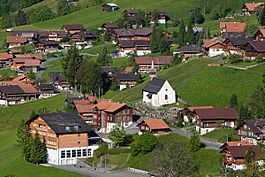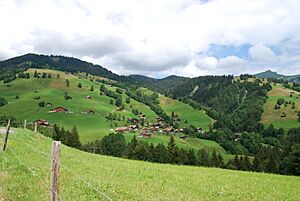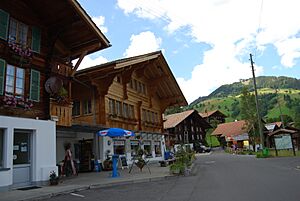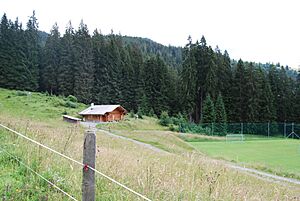Habkern facts for kids
Quick facts for kids
Habkern
|
||
|---|---|---|
 |
||
|
||
| Country | Switzerland | |
| Canton | Bern | |
| District | Interlaken-Oberhasli | |
| Area | ||
| • Total | 51.03 km2 (19.70 sq mi) | |
| Elevation | 1,055 m (3,461 ft) | |
| Population
(Dec 2020 )
|
||
| • Total | 634 | |
| • Density | 12.424/km2 (32.178/sq mi) | |
| Postal code |
3804
|
|
| Surrounded by | Schangnau, Flühli (LU), Oberried am Brienzersee, Niederried bei Interlaken, Unterseen, Beatenberg and Eriz | |
Habkern is a small town, also called a municipality, in Switzerland. It is located in the Interlaken-Oberhasli area within the canton of Bern. The municipality includes several smaller areas like Bohlseiten, Bort, Schwendi, and Mittelbäuert.
Contents
What's in a Name?
The name Habkern comes from an old German word, habuh, which means "hawk". The ending -arra means there are many of something. So, Habkern means "the place where there are many hawks."
A Look Back in Time: Habkern's History
Habkern was first written about in the year 1275. At that time, it was called Habcherron.
The land around Habkern was first owned by the King of the Romans. In 1275, King Rudolph I gave the village to a noble family, the Freiherr of Eschenbach. For a short time, the Habsburg family from Austria owned it. They then gave it to the Interlaken Monastery, which was a religious community.
The monastery supported the Habsburg family. This was even after the Swiss Confederation became independent from the Habsburgs in the early 1300s. The monastery even attacked Unterwalden to help the Habsburgs. Because of this, in 1342, soldiers from Unterwalden attacked and burned Habkern. A few years later, in 1348−49, the village tried to rebel against the monastery but failed.
In 1528, the city of Bern changed its religion to the Protestant Reformation. Bern then tried to make everyone in the Bernese Oberland area follow this new faith. Habkern, along with other villages and the monastery, rebelled against this change, but they were not successful. After Bern took control, they took over the monastery's lands. By 1538, a traveling pastor would preach in Habkern's small church once a month.
For a long time, Habkern's economy depended on farming in the valleys. People also moved their animals to mountain meadows for grazing, a practice called seasonal alpine herding. The scattered farms formed groups called Bäuerten to manage these mountain meadows together.
The first modern road to Habkern was built in 1828. It connected the village to the Unterseen valley. As farming became more modern, fewer workers were needed. Many people had to move to bigger cities or even to Germany or the United States.
By the 1900s, tourism started to grow in Habkern. Two hotels, several vacation homes, and a ski lift were built. Today, about one-third of the people who live in Habkern travel to work in Interlaken or nearby towns.
Habkern's Natural Surroundings
Habkern covers an area of about 51.1 square kilometers (about 19.7 square miles).
- About 39.4% of this land is used for farming.
- Nearly half, 49.9%, is covered by forests.
- Only 1.3% has buildings or roads.
- A small part, 0.8%, is rivers or lakes.
- The remaining 8.6% is land that cannot be used for farming or building.
Most of the forested land is dense forest. Some areas have orchards or small groups of trees. For farming, about 8.8% is used for pastures, and 30.5% is for alpine pastures where animals graze in the mountains. All the water in Habkern is flowing water, like rivers and streams.
The town is made up of many small settlements spread out, rather than one big central village. Some of the larger farming settlements include Bohlseiten, Bort, Schwendi, and Mittelbäuert.
Habkern is in the Bernese Oberland region, near the edge of the Emmental valley. This valley flows from the Hohngant mountain range. Deep underground, there is a large karst cave system called the Siebenhengste-Hohgant-Höhle. A karst cave system is formed when water dissolves rock, creating tunnels and chambers.
In 2010, Habkern became part of a new administrative area called Interlaken-Oberhasli.
Habkern's Coat of Arms
The blazon (description) of Habkern's coat of arms is: "A silver shield with a blue rock, and a hawk standing on it." This means it shows a hawk on a rock, on a silver background.
Who Lives in Habkern?
As of 2010, Habkern had a population of 638 people. About 5.8% of these people were foreign nationals. Between 2000 and 2010, the population slightly decreased.
Most people in Habkern speak German as their main language (98.7%). A very small number speak French or English.
In 2008, about 49.5% of the population was male and 50.5% was female. Most residents (65.7%) were born in Habkern. Others were born in the same canton (22.4%), elsewhere in Switzerland (5.8%), or outside Switzerland (4.8%).
In 2010, children and teenagers (0–19 years old) made up 24.8% of the population. Adults (20–64 years old) made up 55%, and seniors (over 64 years old) made up 20.2%.
Most people in Habkern are married (307 people in 2000). There were 251 single people, 43 widows or widowers, and 23 divorced people.
In 2000, there were 79 households with only one person. There were 22 households with five or more people. Most apartments (53.3%) were lived in all year. About 41% were used seasonally, like vacation homes. Only a small number (5.6%) were empty.
The chart below shows how Habkern's population has changed over time:

Habkern's Economy
In 2011, Habkern had a very low unemployment rate of 0.3%. This means almost everyone who wanted a job had one.
In 2008, 250 people worked in Habkern.
- Most (170 people) worked in the primary sector. This means they worked in farming or forestry. There were about 60 businesses in this area.
- Twenty-eight people worked in the secondary sector. This includes manufacturing (making things) and construction (building things). There were seven businesses in this sector.
- Fifty-two people worked in the tertiary sector. This involves services, like shops, hotels, or education. There were 14 businesses in this sector.
In 2008, there were 151 full-time equivalent jobs. This means if you add up all the hours worked, it's like 151 people working full-time.
- 87 jobs were in agriculture.
- 26 jobs were in the secondary sector, mostly construction.
- 38 jobs were in the tertiary sector. These included sales, transport, hotels, restaurants, and education.
In 2000, only nine workers came into Habkern for work. However, 158 workers left Habkern to work elsewhere. This means many people who live in Habkern work in other towns. About 9.9% of working people used public transport, and 51.2% used a private car to get to work.
Religion in Habkern
Based on the 2000 census:
- Most people (85.7%) belonged to the Swiss Reformed Church, which is a Protestant church.
- A smaller number (2.7%) were Roman Catholic.
- Some people belonged to other Christian churches (12.5%).
- A few people were Buddhist or Hindu.
- About 2.24% of the population did not belong to any church or were agnostic (not sure about God) or atheist (do not believe in God).
- A small number (1.76%) did not answer the question about their religion.
Learning in Habkern
In Habkern, about 35.4% of people have finished non-mandatory upper secondary education. This is like high school. About 4.5% have gone on to higher education, like university or a specialized college (Fachhochschule).
The school system in the canton of Bern works like this:
- One year of non-required Kindergarten.
- Six years of primary school.
- Three years of required lower secondary school. Here, students are grouped by their skills and abilities.
- After lower secondary, students can continue their education or start an apprenticeship (learning a trade on the job).
During the 2010–11 school year, 81 students attended schools in Habkern.
- There was one kindergarten class with 10 students.
- There were three primary classes with 49 students.
- There was one lower secondary class with 22 students.
In 2000, 15 students from Habkern went to schools outside the municipality.
See also
 In Spanish: Habkern para niños
In Spanish: Habkern para niños









